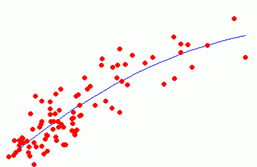Ceres Solver: 高效的非线性优化库(一)
Ceres Solver: 高效的非线性优化库(一)
注:本文基于Ceres官方文档,大部分由英文翻译而来。可作为非官方参考文档。
简介
Ceres,原意是谷神星,是发现不久的一颗轨道在木星和火星之间“矮行星”(冥王星降级之后,同为矮行星)。Google开源了Ceres Solver库,是一个解很多非线性最优化问题的高效、方便的工具。
- 官方网站:http://ceres-solver.org/
- 源码地址:https://github.com/ceres-solver/ceres-solver
- 主要特性:速度快、接口丰富方便、运行稳定。
安装
引用地址:http://ceres-solver.org/installation.html
目前开源方未提供可安装文件。需要源码下载编译。
下载方式,首先安装Git。Git,主流版本管理工具,使用方法见官方文档。
git clone https://ceres-solver.googlesource.com/ceres-solver
依赖项:
- Eigen,好用的数学库,无源码,全部是头文件。
- CMake,工程生产工具,跨平台。
- Glog,log库,选装。TBB,选装。
- Gflags,SuiteSparse, CXSparse,BLAS,LAPACK主要是用来解大型稀疏矩阵的,必须要装。
Linux系统下可以很方便的用命令行安装各种库。
sudo apt-get install cmake libatalas-base-dev libeigen3-dev libsuitesparse-dev
安装Ceres-Solver,根据CMake的方式,进入Ceres目录,
mkdir build & cmake ..
make -j4
sudo make install
可以愉快的使用Ceres啦!先看Example,有示例嘛,学起来更快!
直接运行一下如下结果,
bin/simple_bundle_adjuster ../ceres-solver-1.14.0/data/problem-16-22106-pre.txt
似乎成功了?输出很多内容,好像看不懂。没关系,能运行成功,说明Ceres安装成功,可以愉快的使用。
注:这里解释的是更多在linux下面安装。Widows下基本大同小异,需要花点时间的是SuiteSparse几个三方库的安装和配置,不过也并不复杂。
实战
找到并使用Ceres-Solver
推荐使用CMake工具找到并使用Ceres,类似OpenCV。
什么是非线性最小二乘问题
Ceres-Solver可解形如下列公式的问题
有点复杂,具体什么含义呢?
比如,平面(空间)很多带噪声的点,我们要拟合一条直线(平面)或曲线。比如,三维视觉的全局最优问题。

注意:直线拟合一般也可用线性回归解决。
公式中的目标函数集合称之为残差项,目标是是这个值最小;\(f_i\)函数被称为代价函数,由参数\(x_i\)组成。\(l_i, u_j\)则是函数的取值范围。
下面用了一个具体的示例说明。
求如下目标函数的最小值。
通过求二阶导数我们很容易知道x=10时,最小值取0.但这里我们尝试用Ceres来解决。
- 第一步,代价函数\(f(x) = 10 - x\).
struct CostFunctor {
template <typename T>
bool operator()(const T* const x, T* residual) const {
residual[0] = T(10.0) - x[0];
return true;
}};
代码中符号()是一个模板方法,输入是同一类型。
- 第二步,构建非线性最小二乘问题。
int main(int argc, char** argv)
{
// The variable to solve for with its initial value.
double initial_x = 5.0;
double x = initial_x;
// Build the problem.
Problem problem;
// Set up the only cost function (also known as residual). This uses
// auto-differentiation to obtain the derivative (jacobian).
CostFunction* cost_function =
new AutoDiffCostFunction<CostFunctor, 1, 1>(new CostFunctor);
problem.AddResidualBlock(cost_function, NULL, &x);
// Run the solver!
Solver::Options options;
options.linear_solver_type = ceres::DENSE_QR;
options.minimizer_progress_to_stdout = true;
Solver::Summary summary;
Solve(options, &problem, &summary);
std::cout << summary.BriefReport() << "\n";
std::cout << "x : " << initial_x
<< " -> " << x << "\n";
return 0;
}
AutoDiffCostFunction用CostFunctor作为输入,并提供了一个自动求微分的接口。
计算example/helloworld.cc会得到相应输出结果。
iter cost cost_change |gradient| |step| tr_ratio tr_radius ls_iter iter_time total_time
0 4.512500e+01 0.00e+00 9.50e+00 0.00e+00 0.00e+00 1.00e+04 0 5.33e-04 3.46e-03
1 4.511598e-07 4.51e+01 9.50e-04 9.50e+00 1.00e+00 3.00e+04 1 5.00e-04 4.05e-03
2 5.012552e-16 4.51e-07 3.17e-08 9.50e-04 1.00e+00 9.00e+04 1 1.60e-05 4.09e-03
Ceres Solver Report: Iterations: 2, Initial cost: 4.512500e+01, Final cost: 5.012552e-16, Termination: CONVERGENCE
x : 0.5 -> 10
实际上此示例是个线性问题,却能很好的解释非线性优化的思想。
接下来的文章会处理一些更加复杂的问题,敬请期待。



 Ceres Solver: 高效的非线性优化库(一)
*注:本文基于Ceres官方文档,大部分由英文翻译而来。可作为非官方参考文档。*
Ceres Solver: 高效的非线性优化库(一)
*注:本文基于Ceres官方文档,大部分由英文翻译而来。可作为非官方参考文档。*
